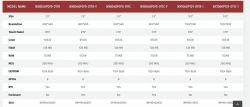What fonts do you use to make the text look nice, for example, in the "SETTINGS" inscription there are no visible spaces after the "I" and the reduced "W" because it looks something like "SETTING A".

Czy wolisz polską wersję strony elektroda?
Nie, dziękuję Przekieruj mnie tamQuote:And what is that?
"#define NextionRS Serial"
Quote:How did you do that you can read incoming data and your library works?

Quote:these are the IDs of the elements on each page, and the page is the most important element on the pageand if id, why do i have all 0?
